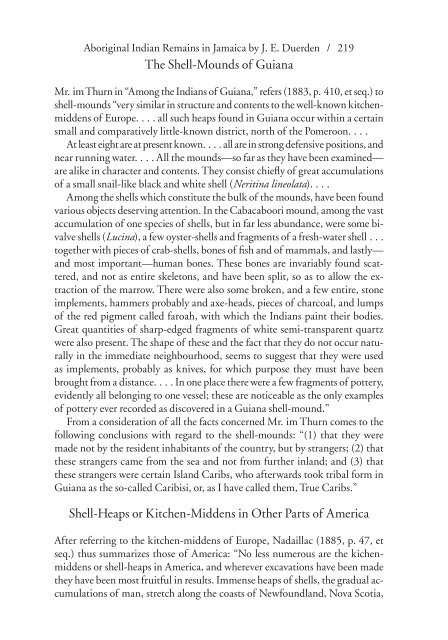Pre-Colombian Jamaica: Caribbean Archeology and Ethnohistory
by Phillip Allsworth-Jones
by Phillip Allsworth-Jones
You also want an ePaper? Increase the reach of your titles
YUMPU automatically turns print PDFs into web optimized ePapers that Google loves.
Aboriginal Indian Remains in <strong>Jamaica</strong> by J. E. Duerden / 219<br />
The Shell- Mounds of Guiana<br />
Mr. im Thurn in “Among the Indians of Guiana,” refers (1883, p. 410, et seq.) to<br />
shell- mounds “very similar in structure <strong>and</strong> contents to the well- known kitchenmiddens<br />
of Europe. . . . all such heaps found in Guiana occur within a certain<br />
small <strong>and</strong> comparatively little- known district, north of the Pom eroon. . . .<br />
At least eight are at present known. . . . all are in strong defensive positions, <strong>and</strong><br />
near running water. . . . All the mounds— so far as they have been examined—<br />
are alike in character <strong>and</strong> contents. They consist chiefly of great accumulations<br />
of a small snail- like black <strong>and</strong> white shell (Neritina lineolata). . . .<br />
Among the shells which constitute the bulk of the mounds, have been found<br />
various objects deserving attention. In the Cabacaboori mound, among the vast<br />
accumulation of one species of shells, but in far less abundance, were some bivalve<br />
shells (Lucina), a few oyster- shells <strong>and</strong> fragments of a fresh- water shell . . .<br />
together with pieces of crab- shells, bones of fish <strong>and</strong> of mammals, <strong>and</strong> lastly—<br />
<strong>and</strong> most important— human bones. These bones are invariably found scattered,<br />
<strong>and</strong> not as entire skeletons, <strong>and</strong> have been split, so as to allow the extraction<br />
of the marrow. There were also some broken, <strong>and</strong> a few entire, stone<br />
implements, hammers probably <strong>and</strong> axe- heads, pieces of charcoal, <strong>and</strong> lumps<br />
of the red pigment called faroah, with which the Indians paint their bodies.<br />
Great quantities of sharp- edged fragments of white semi- transparent quartz<br />
were also present. The shape of these <strong>and</strong> the fact that they do not occur naturally<br />
in the immediate neighbourhood, seems to suggest that they were used<br />
as implements, probably as knives, for which purpose they must have been<br />
brought from a distance. . . . In one place there were a few fragments of pottery,<br />
evidently all belonging to one vessel; these are noticeable as the only examples<br />
of pottery ever recorded as discovered in a Guiana shell- mound.”<br />
From a consideration of all the facts concerned Mr. im Thurn comes to the<br />
following conclusions with regard to the shell- mounds: “(1) that they were<br />
made not by the resident inhabitants of the country, but by strangers; (2) that<br />
these strangers came from the sea <strong>and</strong> not from further inl<strong>and</strong>; <strong>and</strong> (3) that<br />
these strangers were certain Isl<strong>and</strong> Caribs, who afterwards took tribal form in<br />
Guiana as the so- called Caribisi, or, as I have called them, True Caribs.”<br />
Shell- Heaps or Kitchen- Middens in Other Parts of America<br />
After referring to the kitchen- middens of Europe, Nadaillac (1885, p. 47, et<br />
seq.) thus summarizes those of America: “No less numerous are the kichenmiddens<br />
or shell- heaps in America, <strong>and</strong> wherever excavations have been made<br />
they have been most fruitful in results. Immense heaps of shells, the gradual accumulations<br />
of man, stretch along the coasts of Newfoundl<strong>and</strong>, Nova Scotia,


















